An interview with Mark Tercek, president and CEO of the Nature Conservancy, one of the world’s largest conservation groups.
In 2008 The Nature Conservancy (TNC) surprised the conservation world when it selected Mark Tercek, an investment banker from Goldman Sachs, as its new president and CEO. But for people who have worked with Tercek, the move made strategic sense – Tercek was a leading figure in the Goldman’s effort to improve its environmental record. In 2005 Tercek was appointed to head up the firm’s Environmental Strategy Group, which develops and implements its environmental policy, and its Center for Environmental Markets, an initiative that examines market-based solutions to environmental challenges. In that role Tercek worked with pioneers in ecosystem services science, including Gretchen Daily of Stanford University; John Holdren, the former director of the Woods Hole Research Center and currently President Obama’s chief scientific adviser; and Peter Kareiva, chief scientist at TNC.
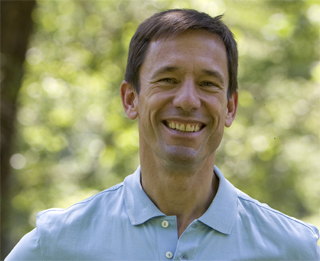 Mark Tercek (Photo by Erika Nortemann/The Nature Conservancy) |
Tercek has joined TNC at an interesting time. The global economic crisis – which has sapped donor funds and undermined support for many environmental initiatives – is presenting serious challenges for many nonprofits, but Tercek is optimistic that some good could eventually arise from the turmoil, leading to a greener economy and more effective conservation strategies.
Speaking with mongabay.com on the sidelines of the Avoided Deforestation Partners meeting on Capital Hill in February, Tercek discussed the impact of the economic downturn on conservation, his transition from investment banking to the nonprofit sector, and the future of U.S. climate policy and carbon finance as a means for saving rainforests.
Mongabay (Rhett Butler): What sort of impact has the economic downturn had on conservation?
Mark Tercek: The violent decline in the stock market has left wealth donors and foundations less confident about their ability to support nonprofit activity. So the short-term, at least, we have to expect contributions will decline. That’s the bad news.
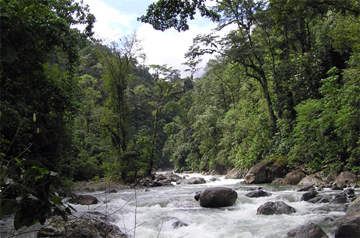 Rainforest stream in Honduras (Rhett Butler). The Nature Conservancy and its partner, Fundación para el Desarrollo y la Conservación (FUNDAECO), are working to conserve the Gulf of Honduras including the Cerro San Gil Protected Area, which is one of the last remaining tracts of very humid tropical forests within the Central American isthmus. |
On the other hand, if you think about the cause of this economic downturn it was people choosing to put off dealing with fundamental economic issues – derivatives, excess leverage, excess real estate prices, excess debt for consumers, excess deficits for the US. All the things responsible for this economic setback have long been understood – people just didn’t deal with them. The longer they waited, the bigger and more difficult they became – as John Kerry said today, “You can pay now or you can pay more, later.” And so we deferred dealing with them and got this enormous bill. But I think one potential silver lining here is that people realize we need to be smarter about facing reality now. In that spirit, perhaps we can hope people will say that we need to think smartly today about addressing important environmental issues that will only get worse if we just do nothing. So that is a tiny bit of a silver lining, a philosophical silver lining.
On the more practical side, there is a deeper opportunity to connect the economic stimulus to environmental matters.
Mongabay: It seems like you chose an opportune time to transition from investment bank to the nonprofit sector. How is the move going?
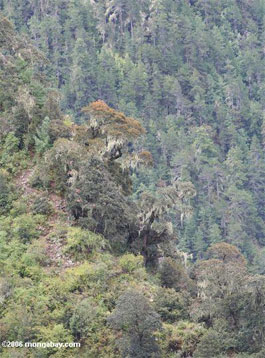 Yunnan golden monkey habitat (Rhett Butler). TNC is working in China’s Yunnan province with local partners to protect the Yunnan golden monkey and its mountain habitat. The critically endangered species dwells in the most extreme environment of any monkey: high-altitude evergreen forests at elevations from 3,000 to 4,500 meters (9,800 to 14,800 feet), where temperatures may fall below freezing for several months in a row. |
Mark Tercek: The transition broadly has been great. I came to the Conservancy because I really believe in the Conservancy’s mission — protecting biodiversity by saving nature. I think it is really a critical one and an urgent one, obviously and I didn’t think any other organization was as well positioned. Now that I have joined, I see that if anything I underestimated the Conservancy’s resources: incredible people and incredible experience: fifty years plus of work and a presence in fifty states. In each state we have a local chapter that is led by important local citizens who are passionate about our mission. Now we have experience in thirty countries, so we take our fifty years of experience in the US and we now apply that to opportunities in the rest of the world. We apply lessons from both US and international work to policy. It is really an extraordinary resource.
We are big. There are great small conservation organizations, to be sure — we partner with them — but there are some things that being big allows you to do too. For example we just closed on a half-billion dollar purchase of land in Montana with the Trust for Public Land. If we didn’t buy it, if there was no other conservation buyer, it would have been developed. That is an example of how being big really can make a difference.
Going back to the current hard times, non-profits broadly – conservation and environmental organizations in particular – will have to be smart about adjusting to a tougher economic environment, including setting priorities. If resources are going to be constrained, and I think they will be, then organizations have to ask the questions: “What are we really best at? What are we uniquely positioned to do?” Then they need to make sure those areas get the resources they need. If there are things an organization isn’t as good at or somebody else can do, those are the areas they should consider pulling away from. These kinds of economic circumstances, require us to do that, and I would like to think that is something I know how to do coming from a cyclical industry in the private sector, I have experience there, so I think I know a little bit about that.
Mongabay: On that front, at Goldman you worked on developing markets for ecosystem services. Going forward, what is critical to making these markets competitive with other forms of land use?
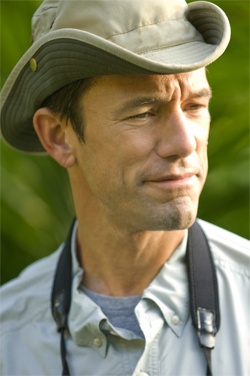 Mark Tercek (Photo courtesy of Mark Tercek) |
Mark Tercek: Well as you know, this area is still very new but I am really interested in harnessing private capitol flows and private economic forces for conservation objectives because as good as TNC is at protecting nature through old fashioned conservation – buying land and protecting it and putting easements on it – it’s obvious that it doesn’t add up to being enough on a global scale. So we have to do something more to favor conservation over other types of land use and make it economically viable for local people since it is they who will ultimately determine the fate of these ecosystems. For example in Ecuador we persuaded down stream industrial users of the water supply to pay for upstream watershed protection of the Condor Bioreserve. It is a similar to New York City’s conservation of the Catskills and it really works well. Now we are developing a comparable project in Bogota. So we are very interested in projects that harness ecosystem services — paying for the attributes of nature by the private users of the services. Under this model conservation projects can be driven by economic forces. That is really exiting.
Another example is in the Solomon Islands where we worked with the local community to help them manage their marine protect areas. What we learned is that through good management their food supply improved, fishing improved, ecotourism improved, and per-capita income improved. So this is another really great example, really tangible and measurable, of how human well-being improves as a consequence of smart conservations processes.
Mongabay: So you are basically talking about alternative models for funding conservation.
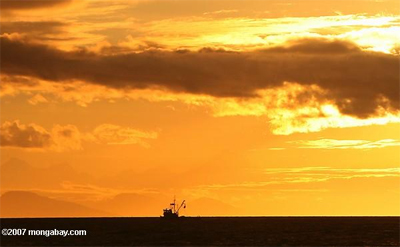 Trawler at sunset (Rhett Butler). In 2006 TNC purchased seven federal trawling permits and four trawling vessels from commercial fishermen, becoming the first private organization to buy out Pacific fishing permits and boats for conservation purposes. |
Mark Tercek: Alternative models. There is one more that I will give you that I think cool. It is not that new, but it’s really cool. In California we bought fishing vessels and the trawling licenses that go with them. This is the most harmful way to do fishing. Now we are leasing them back to fishermen who are interested in fishing on a sustainable basis, with the cooperation of the local regulatory authority. In the prices we are demonstrating how sustainable fishing can be accomplished.
We’re interested in all these opportunities to partner with the private sector so that we can see conservation at a faster pace, bigger scale.
Mongabay: TNC is expanding its presence overseas – or you were up until recently – but a lot of people think of you primarily as a U.S. organization, right?
Mark Tercek: People think of us as a US-based organization because we are a huge success in the US. We’re in fifty states, we have been here for more than fifty years and we really are doing great work in the U.S. So that distinguishes us. But we are just as active internationally. We’re in thirty-plus countries. I don’t think any other conservation organization is as big as us internationally. What is interesting about this is we can take advantage of what has been done in the US and apply it overseas.
 Bamboo forest in Colombia (Rhett Butler). TNC has created a conservation trust fund to protect rivers and watersheds in Colombia, thereby helping provide clean drinking water to Bogotá. |
For example, our Colorado chapter has adopted Mongolia because the grassland habitat is similar there. So really great things happen- our partners and staff from Mongolia visit Colorado, they see how grassland restoration can occur in a developed country. They can spend time with our scientists and learn from them. In turn, our team in Colorado can go to Mongolia and be inspired by the opportunity to do more. Our domestic and international programs really reinforce each other nicely.
Mongabay: Getting back to ecosystem services, specifically REDD since that’s what we’re in town today to discuss, what do you think needs to be done to take it to the point where it is a reality? Policy?
Mark Tercek: I think it is mostly policy driven. There are non-policy aspects too, but I think the most urgent thing is to have U.S. leadership on climate. This has to be done through legislation. If there is no U.S. legislation by Copenhagen this December, I really fear European countries will lose the momentum because their business interests will say this isn’t fair. “Why should we go out ahead of the US?” It’s a fair question. Therefore it is absolutely critical that the US have legislation in place as soon as possible. Now it is not an easy time for legislation to be passed due to the economy. But that is what I think we should press for, first and foremost.
The Nature Conservancy is part of the US Climate Action Partnership which is one very comprehensive proposal for how a cap and trade system might work in the US. It has the support of a lot of business interests. So that is at least a step in the right direction.
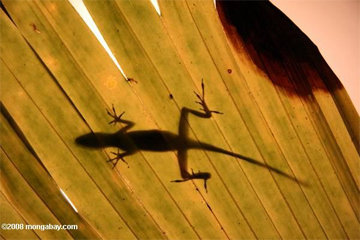 Anole lizard on a left in the Costa Rican rainforest (Rhett Butler). TNC helped Costa Rica launch a $26 million debt-for-nature swap that protected the Central American country’s biodiverse rainforests. |
Part two for REDD is that legislation must include forest carbon, both U.S. and overseas forest carbon. I think that actually might be easier to accomplish than others. If we had the U.S. legislation I don’t think it would be difficult to persuade diverse interests that it makes sense to include forest offsets. They have to be credible forest offsets to be sure, but that can be accomplished. Business interests like it because they are interested in cost containment measures, and we all should be interested in cost containment measures. We will be more successful with legislation in the U.S. these measures are less harmful to the economy, so cost containment matters. Forestry offsets are a great way to accomplish that. Plus you get multiple wins from forestry offsets. Not only do you store carbon, you also lower costs, protect biodiversity, and help people in forest countries who depend on the forest for their survival and livelihood. So it is win, win, win, win, win.
Mongabay: What’s ahead for TNC and REDD? TNC really pioneered avoided deforestation with Noel Kempff – and you did it before a market existed and carbon was worth next to nothing.
Mark Tercek: Well yes, Bolivia showed that it could be done. The technical issues that people worry about can be accomplished. It doesn’t mean it will be easy at the outset, but it can be done. It is important to set high bars for certification standards to ensure that the system is credible. Local people must absolutely be engaged and benefiting economically from projects.
In Indonesia we have a new project where we are trying to demonstrate again that it can be accomplished. It’s difficult but in time we will be able to line up the governance that we need, the sustainable forestry operators, and the local people. The project will protect critical orangutan habitat on Borneo and prevent large-scale emissions from deforestation and conversion of peatlands.
Thank you to Tiffany Roufs for assistance with the transcription of this interview.